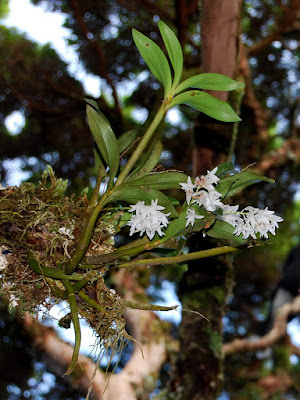Dendrobium moorei is endemic to Lord Howe Island in between Australia and New Zealand. It grows on trees and rocks in humid, sheltered forests at elevations below 1000 meters above sea level.
Dendrobium moorei also called as Moore's Dendrobium, Drooping Cane Orchid, Callista moorei, Thelychiton moorei, Tropilis moorei, is a species of the genus Dendrobium. This species was described by Ferdinand von Mueller in 1870.
IDENTIFY DENDROBIUM MOOREI ORCHID PLANT
Dendrobium moorei is endemic to Lord Howe Island in between Australia and New Zealand. It grows on trees and rocks in humid, sheltered forests at elevations below 1000 meters above sea level.
Moore's Dendrobium is a small sized, cool growing epiphyte, lithophyte and terrestrial with basally thickened, angled and furrowed, 10-20 cm long and 0.6-0.8 cm wide stems carrying 2 to 6 apical, lanceolate, leathery, thin textured, 6-15 cm long and 1.5-2 cm wide leaves.
Drooping Cane Orchid blooms in the fall and winter on a 15 cm long, racemose, many flowered inflorescence arising from nodes near the apex with waxy, fragrant flowers. The flowers are small, graceful, pure white frosted-looking. The labellum sometimes with faint pink markings with a triangular, crinkled middle lobe.
DENDROBIUM MOOREI ORCHID PLANT CARE AND CULTURE
Cultural information should only be used as a guide, and should be to be adapted to suit you. Your physical location; where you grow your plants, how much time you have to devote to their care, and many other factors, will need to be taken into account. Only then can you decide on the cultural methods that best suit you and your plants.
Light:
Dendrobium moorei do best in full sunshine (25000-50000 lux), close to the glass where glasshouse treatment is required. In addition to the natural light, you will have to use artificial light lamps.
Temperature:
The average temperature of the summer day is 24-25 ° C, night 20 ° C, giving a daily difference of 4-5 ° C. In winter the average day temperature is 11-14 ° C, night 7-10 ° C, giving a daily difference of 4-5 ° C.
Humidity:
For most of the year, Drooping Cane Orchid need the humidity of almost 80%, but at the end of winter and at the beginning of spring it drops to around 60%. Too dry air has a negative effect on the development of the plant: its growth is inhibited, and the leaves begin to turn yellow and dry out. The higher temperature, the higher the humidity should be, and the higher the humidity, the more often and longer it is necessary to ventilate the room where the plants are contained, otherwise the probability of rotting and various kinds of fungal diseases.
Substrate, growing media and repotting:
Dendrobium moorei grows best in pots with staghorn peat as substrate (crocks and charcoal at the bottom of the pot). After potting, keep the plant in a cool, shady place for a few days before placing it in its growing position. Do not overpot. Use the smallest pot that will accommodate your plant.
It does not need frequent repot, therefore, it is desirable to transplant only when it is really necessary, for example, in cases of strong salinization or compaction of the substrate, at its critically high or low pH (the norm is from 5.5 to 6.5) or when the plant grows very strongly and the pot becomes cramped to it (pseudobulbs begin to hang from the edges of the pot). Repotting is best done immediately after flowering when new roots and new growth begin to grow.
Watering:
Moore's Dendrobium will need heavy watering from the commencement of Summer until the first chill spell of Autumn, when watering should practically cease until the new shoots appear in Spring. Watering is directly dependent on the temperature of the content, the higher it is, the more often it needs to be watered. When watering, excess water should flow freely from the pot, since stagnation of water both inside the pot and in its pan can very quickly lead to rotting of the roots and the lower part of the plant.
Fertilizer:
It is recommended to use a 1/4-1/2 dose of orchid fertilizer weekly. You can use the balanced fertilizer throughout the year or from spring to mid-summer use high-nitrogen fertilizer, and then until the end of autumn high-phosphoric fertilizer to stimulate flowering.
Rest period:
Dendrobium moorei need less water in the winter, especially if they grow under the conditions of a dark, short day that occurs at moderate latitudes. They should dry somewhat between waterings, but they should not be dry for a longer period. Frequent morning fogging and rare, economical watering should allow the plant to go through a dry period of rest, while providing it with sufficient humidity. Fertilization should be reduced or eliminated until new growths appear and a more abundant spring watering begins.















COMMENTS